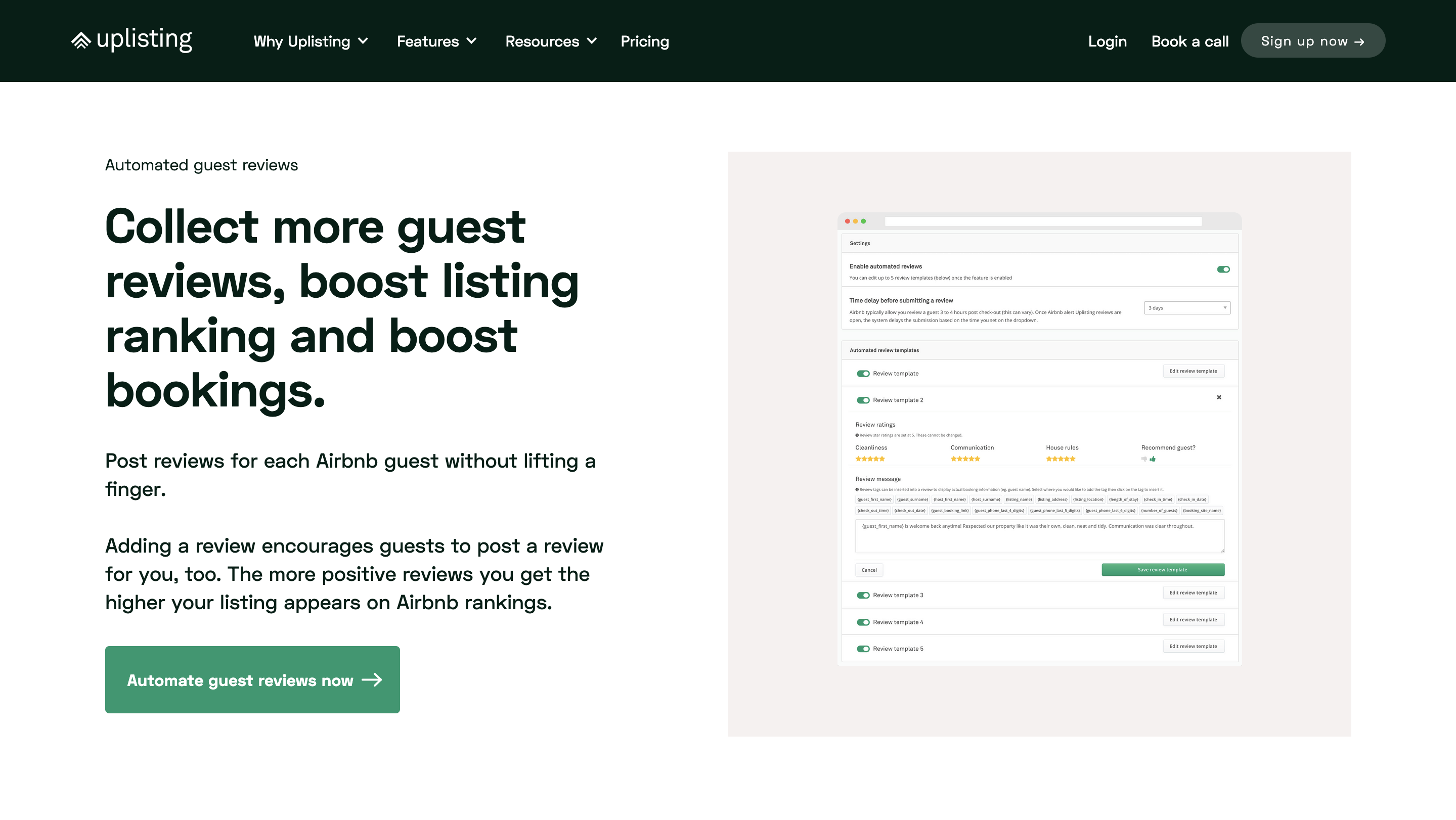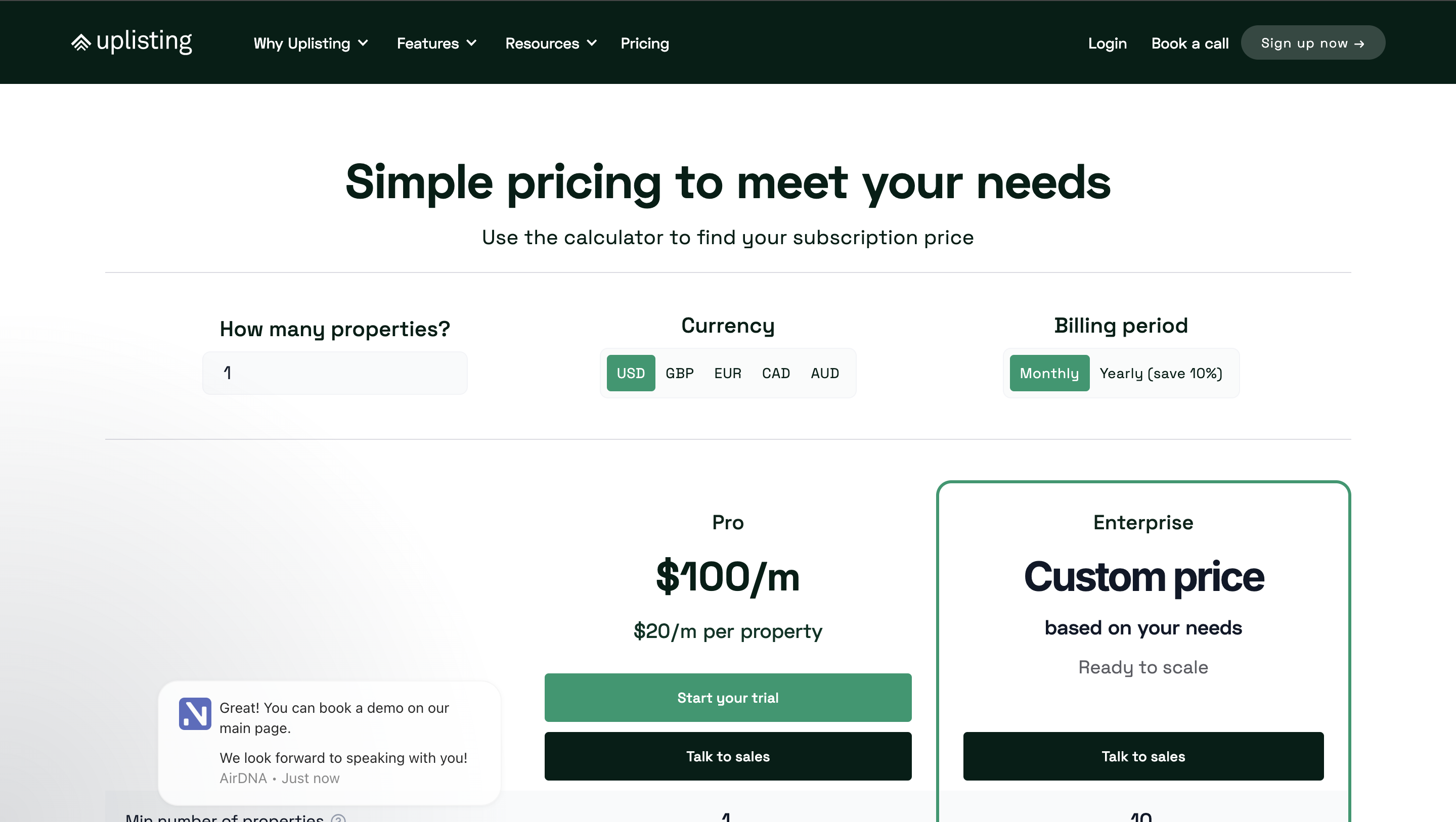Learn How To Manage Your Rental Property on Airbnb
Get access to our 5-day training course on managing your vacation rental property in Dubai.
Download GuideWe’ve been searching for the right short term rental management system for Homevy. And so far, we’ve had demos for Guesty and Hostfully.
Guesty’s pricing felt a bit high, while Hostfully had complex (but appealing) features. So, we moved to the next one on our list—Uplisting.
We figured our hands-on demo experience might be helpful to other property managers in the same shoes, searching for the perfecttttttt property management software. Or is perfection a myth? We shall find out.
In this review, we’ll break down how Uplisting performed during our demo: what stood out, where it fell short, and why it stayed on our radar longer than most.

Photo by Marcus Aurelius
Uplisting doesn’t try to do everything, and we believe that’s part of what makes it work. The layout is clear, with a calendar that gives you a proper overview and a message system that doesn’t make you dig through threads to find what matters. It’s the kind of tool that doesn’t get in the way. You open it, and within seconds, you know what’s happening across your properties.
Guest messages are automated but still feel personal, and syncing with platforms like Airbnb and Booking.com happens quietly in the background. Even the booking site feature is there if you need it, but it doesn’t try to sell itself as a full-blown website builder. It all feels intentional—built for day-to-day use.
That said, it’s not without limits. The mobile app still feels a few steps behind, and the interface, while clean, could benefit from certain refinements, especially when you’re working quickly. But overall, Uplisting felt like a platform made for people who want to get things done without being slowed down by the software itself.
During the demo, the Uplisting representative moved through the system without jumping around unnecessarily. Tasks like checking bookings or replying to guests didn’t take more than a few clicks, and the layout made it easy to see where everything was.
Channel management was shown in action—Airbnb, Booking.com, Vrbo—all syncing without much friction. Automated messages and triggers were set up so easily; there was literally no issue. It was clear that the system wasn’t just built for functionality, but also for repeatable, daily use.

Photo by Uplisting
After paying careful attention during the demo, these were the features that stood out the most:
As mentioned earlier, connections to Airbnb, Booking.com, and Vrbo held up well. The calendars updated quickly, which meant we weren’t worried about double bookings. Rate tweaks and availability changes all synced across platforms smoothly, without anyone needing to hover over a dashboard all day.
The unified inbox was a small change that made a big difference. All guest chats were in one place. And with automated messages kicking in at just the right moments—like booking confirmations or check-in reminders—guests stayed in the loop, and we wouldn’t need to follow up manually.
The automation didn’t feel forced. We noticed they’d work with us, not against us. We could set up alerts, link tools we already used, and personalize how guest interactions were handled. Routine stuff got done automatically, but there was still room for a human touch when necessary.
Payments, reports, and deposits were all easy to track without needing ten tabs open or a ton of spreadsheets. The system didn’t just cover the basics; it handled extras like seasonal rates and add-on guest services without making things complicated. It felt solid enough to grow with us.
Getting started with Uplisting felt refreshingly simple. The layout just made sense. There were no confusing menus or hidden features, so our team would pick up the basics pretty quickly – which would make onboarding new team members way smoother.
Everything was right where you’d expect it to be, usually just a click or two away. Even on mobile, the experience held up well. The interface was responsive, and all the important stuff worked just fine on phones and tablets.

Photo by Uplisting
Uplisting’s pricing was pretty easy to understand. Plans kicked off at $100 a month for up to 10 properties, and if you needed more, you could add them at a lower rate. Basically, it scaled as your portfolio grew.
Uplisting sat somewhere in the middle compared to other tools we looked at—not the cheapest, but definitely a solid value for the reliability and features it delivered. We also liked that there were no surprise setup fees or long-term commitments. That flexibility gave us some breathing room as our needs changed.
That said, we had to factor in a few extras. While Uplisting was relatively cheap (compared to other tools) it didn’t cover everything out of the box. This included things like deeper maintenance tracking or more detailed owner reporting. So, we had to account for the cost of extra tools to fill those gaps. It’s something to keep in mind when planning your budget.
Honestly, Uplisting covered the essentials well, but there were two areas where it came up short for us.
1. The biggest gap was in maintenance and task management.
There wasn’t a built-in way to create, assign, and track tasks, especially across team members or with third-party vendors. For a company like ours, where quick fixes are non-negotiable, that was a bit of a red flag. We’d either have to plug in another tool or build a manual workaround to stay on top of it all.
2. The second limitation was in owner reporting.
While it did the basics, like showing key financials, the reports didn’t offer the level of detail or customization we needed to keep our owners fully informed. For the kind of professional, polished reports our property owners expect, we’d likely have to generate those separately or use another system alongside Uplisting.
What genuinely stood out about Uplisting was how smooth it made the essentials. Channel management was solid. The interface was clean, and bookings synced almost instantly. That cut down the risk of double bookings or calendar clashes, which is a big deal in Dubai’s short term rental market. The system felt thoughtfully designed, focusing on what actually matters without piling on unnecessary features.
Regardless of all these, Uplisting didn’t meet all our needs. Crazy right? The lack of strong maintenance tracking and limited owner reporting meant we’d have to rely on extra tools or manual workarounds—something that just didn’t align with the full-service experience we aim to deliver at Homevy.
So, we moved on to the next vacation rental management software on our list—Avantio.
Get access to our 5-day training course on managing your vacation rental property in Dubai.
Download Guide